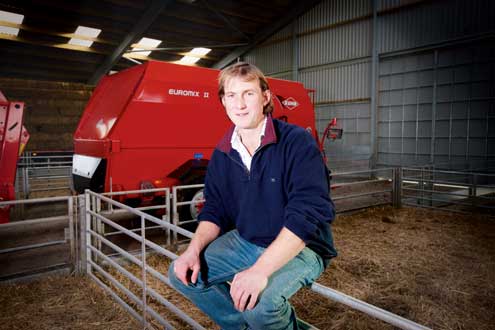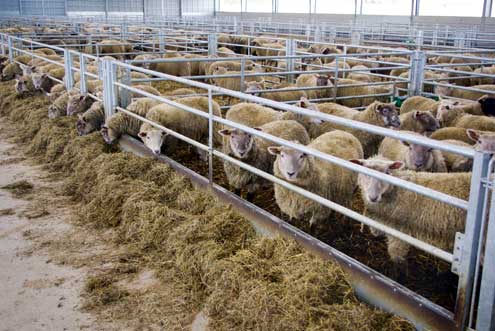Feeding lambs TMR could help cut costs

A summer of unsettled weather has left sheep producers with a surplus of lambs difficult to finish.
Coupled with the fact cereal costs have reached dizzy heights, many farmers are weighing up the cost of finishing stock.
But using home-grown forages and feeding a total mixed ration (TMR) could dramatically ease pressure on bought-in concentrates and labour at a time when many farmers will be feeling the pinch.
Leicestershire sheep producer Gareth Owen decided to trial a TMR diet last winter to finish his Charollais- and Suffolk-sired lambs.
Mr Owen, from Hill farm, Launde, has fed his ewe flock of Mules TMR for the past four years. But after recently investing in a purpose-built sheep shed, he decided to move away from a traditional cereal-based regime for finishing winter lambs as well.
| Lamb DLWG when fed a TMR | |
|---|---|
| Period average | DLWG (g/day) |
| 10 Nov – 14 Dec | 262 |
| 14 Dec – 28 Dec | 110 |
| 28 Dec – 15 Jan | 50 |
| The DLWG figures demonstrate the compensatory effect of the first month post-housing. | |
“The emphasis of the business is to maximise the use of high-quality forage and TMR is the most logical way of doing that,” he explains.
“We graze pastures that are difficult to finish lambs outside, such as traditional parkland and poor permanent pasture. This system allows the lambs to grow outside and then we bring them inside to put the final finish on them.”
Last year lambs were brought inside in November in groups of 500 for five weeks – starting with the heaviest – and were fed on a TMR diet once a day.
“We weighed all the lambs and drew off the heaviest. We didn’t bring anything in under 32kg.”
TMR was made daily using a mixer wagon and was predominantly forage-based, supplemented with 150kg of brewer grains, 60kg soya beans, 50kg of molasses and 8kg of minerals.
Costs
Performance was recorded by independent sheep consultant Lesley Stubbings, in conjunction with EBLEX.
Preliminary investigations found that the TMR regime – including straw and silage – was less than half the cost of creep feeding, at 12p and 30p respectively.
Lambs were weighed at regular intervals every two weeks over the finishing period and results showed lambs gained about 10kg each over 50 days, with most of the group housed first sold by December.
The initial 500 lambs housed averaged 262g a day, so the cost of 1kg gain was 46p.
But Mr Owen says one of the biggest cost benefits has been labour. “Moving from twice-a-day feeding to feeding once a day, ad lib, immediately halves the costs.”
Feeding lambs TMR has also meant Mr Owen can prioritise grazing for ewes until they are housed in January, ready for lambing.
Growth rates and feed conversion efficiency
Daily liveweight gain varied considerably from November through to January (see table p44).
Ms Stubbings says this was a result of compensatory growth rates in the early stage of feeding.
“If lambs have been growing slowly over a period of time and you put them on a higher quality diet they will compensate for the slow growth period by growing faster,” she explains.
“Results showed feed conversion efficiency improves significantly with daily liveweight gain (DLWG).
“For example, at 100g DLWG, lambs eating 1kg of dry matter were converting at a rate of 10:1 [kg dry matter: kg gain]. But if this improved to 200g DLWG while eating 1kg of dry matter the conversion rate is 5:1.”
Ms Stubbings says this illustrates how important it is to ensure feed is of good quality and animal health status is high to maximise daily liveweight gain early on and get lambs sold soon.
“The faster lambs grow, the more efficient their feed conversion rate. That’s why it is important to pick them up sooner, because the initial growth stage is key to getting them growing fast.”

Trial work found it cost 12p a lamb a day to finish lambs on a TMR, versus 30p a day for creep feeding.
Forage quality
Mr Owen says good-quality forage has been essential in maximising DLWG and reducing the need for bought-in concentrates.
“We aim to use as few supplements as possible. Silage is the cheapest feed you can use, but the determining factor is the quality of forage,” explains Mr Owen.
“Making good-quality forage that is consistent is key.”
At Hill Farm this has been achieved through careful management and by growing grass specifically to make quality forage.
“We re-seed regularly and treat silage leys like an arable crop, which we’ll cut two to three times.
“We have overgrazed in the past and the knock-on effect to quality and quantity was quite severe.
“Instead we now graze very lightly in the autumn and don’t graze at all through the winter.”
Mr Owen says the most important part of using TMR to feed lambs is having faith in the forage quality and not underestimating its ability.
“The danger is over-supplementing, because you tend to believe it won’t do what it should, but it does,” he says.
Analysing forage is a key part of that process and acts as the foundation for building a high-quality TMR mix, explains Mr Owen.
“It is the starting point and without that it is almost impossible to build an effective TMR.”
After receiving results from this year’s silage analysis, Mr Owen anticipates he will be using more supplements to compensate for the shortfall in quality.
Flexibility
But despite the disappointing results he says TMR will still give him the flexibility to source the most cost-efficient supplements, even in a year with feed price volatility.
“There will be several options for achieving our end result and we can pick and choose which is the most cost-efficient.
“Even in a year like this we still have flexibility. We are not subject to huge changes in protein and cereal price, because the quantity of supplements we buy is minimal.”
Meanwhile, this year at Hill Farm Ms Stubbings will be looking to improve DLWG by evaluating the effect of shearing lambs at housing and bringing them inside earlier.
